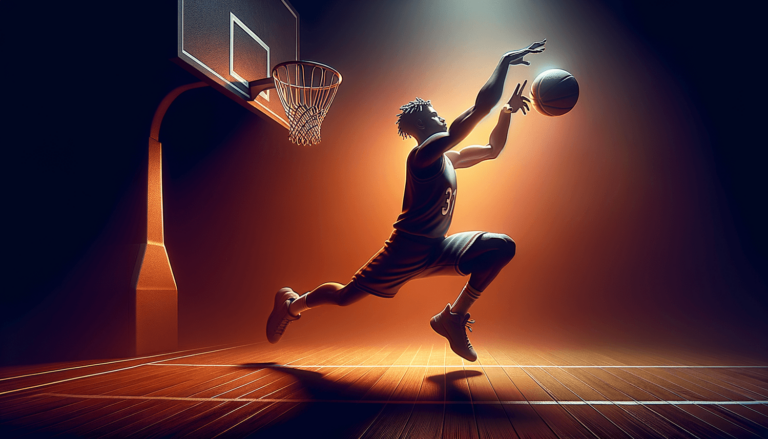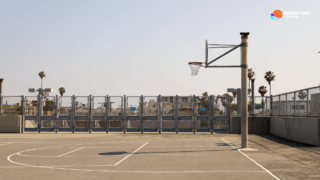
As you immerse yourself in the exhilarating world of basketball, you might have come across the term “tear drop” and found yourself wondering what this mysterious move is all about. In this blog post, we’ll dive into the fascinating art of the tear drop, a high-skill maneuver that has left countless fans jumping out of their seats in awe. Get ready to impress your friends with your newfound knowledge, as we break down the technique, history, and famous tear drop moments in basketball!
What’s a Tear Drop in Basketball?
A tear drop in basketball, also known as a floater or runner, is an offensive move where a player shoots the ball with a soft, high-arching trajectory over the outstretched arms of taller defenders. Usually executed in the paint or close to the basket, this maneuver requires skill, touch, and a strong sense of timing to be effective. The tear drop is particularly popular among smaller guards who need to score over taller interior defenders.
The Origin of the Tear Drop
The tear drop has been around since the early days of basketball, although it was not always as widely popular or recognized as it is today. The shot has evolved over time as players honed their skills and capitalized on their creativity to score on the court. This enticing offensive technique has become a staple in modern basketball, thanks in large part to the NBA players who have mastered the move and inspired others to do the same.
The Birth of the Tear Drop
While there is no definitive or widely agreed-upon answer to the tear drop’s origin, some have attributed its development to NBA legend Bob Cousy. Cousy, who played for the Boston Celtics from 1950 to 1963, was known for his craftiness and ability to create scoring opportunities on the court. His innovative no-look passes and clever scoring tactics set the stage for the eventual popularization of the tear drop.
Mastering the Technique
To truly understand what sets the tear drop apart from other shots in basketball, let’s break down the technique and discuss the essential components of this elusive move. Mastering the tear drop requires a blend of finesse, timing, and touch—making it a difficult yet rewarding maneuver for those willing to put in the practice.
Body Positioning
One of the most critical aspects of successfully executing a tear drop is proper body positioning. As the player drives towards the basket, they must maintain balance by focusing on their center of gravity, keeping their core tight, and staying low to the ground. Additionally, the player should lean slightly into their defender to create separation and prevent the defender from blocking their shot.
The Release
A proper release is vital to the tear drop’s effectiveness. To execute the shot, the player must lift the ball above their head with a high release point while simultaneously avoiding contact with the defender. It is crucial to release the ball with a gentle touch and a high arc in order to sail it over the outstretched arms of taller defenders. Practicing the release and the arc of the shot is integral to achieving optimal results.
Practice Makes Perfect
As with any skill in basketball, practice is the key to success when it comes to the tear drop. Spending time on the court honing your tear drop technique will lead to increased confidence and better results in game situations. The more you practice, the more naturally the move will feel, and the better your chances of success.
NBA Stars and their Signature Tear Drops
Throughout the history of basketball, many players have left their mark by showcasing their prowess with the tear drop. From Cousy in the early days to the present stars of the NBA, players have made a name for themselves with this flashy and effective move.
Tony Parker: The King of the Floater
In modern basketball, few players are more synonymous with the tear drop than former San Antonio Spurs point guard Tony Parker. Boasting an incredible touch around the rim, Parker became the poster boy for the tear drop during his illustrious NBA career. He routinely left defenders in the dust with his lightning-fast speed and silky-smooth runners, making him one of the most feared guards in the game.
Stephen Curry: The Unstoppable Force
Stephen Curry, two-time NBA MVP and three-time NBA champion, is known for his otherworldly shooting ability from beyond the arc. However, his offensive arsenal also includes a nasty tear drop that leaves defenders scrambling. Curry’s quick release and exceptional touch make it nearly impossible to guard him, as he regularly demonstrates on the court by making the impossible look routine.
Kyrie Irving: The Master of the Finishing Touch
Kyrie Irving is widely regarded as one of the best ball handlers and finishers in the NBA, and his tear drop is a significant part of that reputation. With a remarkable ability to create space and finish at the rim, Irving’s tear drop has become an essential weapon in his offensive toolkit. His ability to navigate through traffic and finish with a soft float over taller defenders is nothing short of incredible.
Incorporating the Tear Drop into Your Game
While the tear drop is a high-level move that requires precision and practice, even the casual basketball player can make it a part of their toolkit. By spending time honing your skills and studying the game’s top players, you can incorporate the tear drop into your own game and take your scoring ability to new heights.
Watch and Learn
To get a sense of the tear drop’s mechanics, watch plenty of basketball and observe the nuances of how players like Curry, Parker, and Irving utilize the move. Studying their body positioning, release, and touch will help you gain a deeper understanding of the tear drop’s fundamentals.
Practice, Practice, Practice
As mentioned previously, practice will be the cornerstone of success when it comes to mastering the tear drop. Spend time at your local court working on your positioning, release, and touch both with and without a defender. Remember: repetition builds confidence, and confidence breeds success.
Ask for Constructive Feedback
Don’t be afraid to ask for help or feedback from your coaches or teammates. They may offer valuable advice and fresh perspectives on how to improve your tear drop technique. Constructive feedback can be invaluable to reaching your full potential as a basketball player.
Why the Tear Drop Matters in Basketball
The tear drop’s importance in basketball stems from its ability to counteract the defensive tactics of taller players in the paint. It presents a viable scoring option for smaller players, forcing defenses to account for the threat of the tear drop at all times. With proper execution, the tear drop has the potential to be a game-changer on the court and a valuable addition to any player’s skillset.
Countering Shot Blockers
The tear drop is an effective weapon against shot blockers due to its high, soft release. While traditional layups and jump shots can be easy targets for taller defenders, the tear drop’s distinct arc makes it difficult to block. In this way, the move levels the playing field and ensures that defenders must remain vigilant against the shot.
Creating Space
As a player becomes more proficient in executing the tear drop, defenders must respect the threat of the move. This can create additional space for other offensive options, such as drive-and-kick plays, jump shots, or passes to cutting teammates. The tear drop’s versatility and ability to draw defensive attention makes it an essential skill for any offensive-minded player.
Enhancing Overall Game
Lastly, the tear drop’s impact goes beyond merely scoring. As players work to improve their tear drop technique, they will also develop valuable skills such as body control, touch, and timing. These skills are transferable to other aspects of the game and can yield significant benefits for a player’s overall abilities on the court.
Embarking on the journey to master the tear drop can greatly enhance your basketball expertise and set you apart on the court. With diligent practice, observing the pros, and smart implementation, you’ll soon find yourself floating the ball with precision over the outstretched arms of defenseless opponents.
Optimizing the Tear Drop for Different Situations
As your skills with the tear drop continue to develop, it’s important to understand how best to utilize the move in varying situations. Adapting the tear drop to different game circumstances can give you a significant advantage on the court and enable you to keep the defense guessing.
Driving into Traffic
Heading straight into the paint where the defense is tightly packed can be an ideal scenario for the tear drop. The soft, high-arching shot allows you to weave through defenders and capitalize on even the smallest seams in the defense. As long as you maintain control and protect the ball, the tear drop can help you score even among a sea of shot-blocking giants.
Off the Dribble or One-footed Jump
One of the beauties of the tear drop is its potential for adaptability. Depending on the situation, you might want to use the tear drop off the dribble, for which timing is crucial, or a one-footed jump, providing you with an additional edge. Working on both options in practice will give you the flexibility to utilize the tear drop in different situations, keeping your opponents on their toes.
Splitting Defenders or Using a Screen
Becoming proficient in using screens to get open, or expertly splitting defenders, can significantly improve the effectiveness of your tear drop. When using a screen, be prepared to read defenders’ reactions, and leverage the space created to execute a textbook floater. Likewise, when splitting defenders, quickness and cunning are paramount, as you swoop in for a soft tear drop amid bewildered defenders.
The Defensive Perspective: Guarding the Tear Drop
In basketball, possessing a defensive mindset is just as crucial as mastering the art of scoring. If you’re tasked with stopping an opponent who is proficient in the tear drop, understanding how to defend against the move can come in handy.
Contest Shots without Fouling
When defending against a player driving to the basket for a tear drop, it’s crucial to maintain balance and avoid fouling. Sudden, aggressive movements can lead to unnecessary fouls, so timing and good footwork are essential. Focus on keeping your hands high and slightly extended, contesting the shot by affecting the shooter’s vision and comfort without making contact.
Study Your Opponent
Just like offense, defense relies heavily on understanding and anticipating your opponent’s moves. Studying your opponent’s tendencies, including their preference for executing tear drops, will give you a clear edge on the defensive end. Be prepared to jump into the passing lane, take a charge or active hands to disrupt their shot.
Team Defense
Lastly, remember that strong team defense is the backbone of defending against any move, including the tear drop. In-game communication and teamwork will pay off when positioning yourselves to contest shots and cover driving lanes effectively. Working together as a unit will make defending against skilled tear drop shooters much more manageable.
Mastering the tear drop, optimizing it for different situations, and understanding the defensive aspects of the move are all critical parts of becoming a well-rounded basketball player. With the knowledge and practical experience, you’ll find yourself in possession of a valuable tool to excel in the game and leave your opponents mesmerized.
Frequently Asked Questions
In this FAQ section, we’ll answer some of the most commonly asked questions about the tear drop in basketball. Whether you’re a seasoned veteran or a basketball newbie, these questions and answers will help expand your knowledge and understanding of this spectacular move.
1. What’s the difference between a tear drop, floater, and runner?
There is no practical difference between a tear drop, floater, and runner—they are simply different names for the same high-arching shot in basketball.
2. Can taller players effectively use the tear drop?
While the tear drop is particularly popular among smaller guards, taller players can also effectively use the technique with practice. The maneuver can be valuable for any player looking to add a diverse scoring option to their repertoire.
3. Is the tear drop only effective near the basket?
While the tear drop is most commonly used in the paint or close to the basket, skilled players can execute it from mid-range as well. However, the shot’s high arc and soft touch make it particularly effective when employed close to the rim.
4. How can I improve the accuracy of my tear drop?
Practice is the key to improving your tear drop accuracy. Focus on your body positioning, release point, and touch, and work to generate a consistent arc and trajectory. Seek feedback from coaches and teammates to further fine-tune your technique.
5. Is the tear drop good for all levels of play, including youth basketball?
Yes, the tear drop can be a valuable skill for players at all levels, including youth basketball. Developing proficiency with the tear drop at a young age can contribute to a more versatile and potent offensive skillset in the future.
6. Can I use the tear drop in a pick-up game?
Absolutely! The tear drop can be a fun and effective move in pick-up games, recreational leagues, or organized competition. Adding the tear drop to your arsenal can make you a tougher opponent to guard in any setting.
7. How do defenses typically try to stop the tear drop?
Defenses usually attempt to stop the tear drop by contesting the shot without fouling, maintaining good positioning and footwork, and relying on strong team defense. Studying your opponents and adapting your technique accordingly can be critical to your success with the tear drop.
8. Can the tear drop be blocked?
While the tear drop can indeed be blocked, it is challenging due to its high arc and quick release. The move is most effective when executed over the outstretched arms of taller defenders, minimizing the risk of being blocked.
9. Should I only use the tear drop when closely guarded by a defender?
While the tear drop is especially useful against tight defense, it can also be a solid scoring option in various situations, depending on your comfort level and mastery of the move. Don’t be afraid to experiment with the tear drop in different contexts to expand your offensive arsenal.
10. How can I incorporate the tear drop into my game if I am not a guard?
Players in any position can incorporate the tear drop into their game by practicing the technique and learning from the best. Watch how skilled tear drop shooters execute the move, and work to adapt it to your own unique style of play. With consistent practice and a willingness to learn, you can become proficient in using the tear drop regardless of your position on the court.
Featured Posts
- No pillar pages found.




